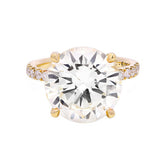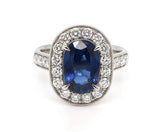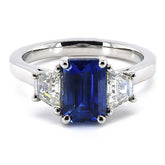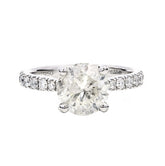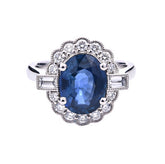Gemstones have long captivated us with their elegance, rarity, and symbolism. Thanks to technological advances, lab-created versions of natural gemstones have entered the market in recent years—sparking an ongoing debate about their differences. The conversation surrounding lab-grown diamonds vs natural diamonds continues to grow, especially as more people seek out alternatives for their engagement rings and fine jewellery. Understanding the differences is key to making an informed choice.
What Are Natural Gemstones?
Natural gemstones are minerals or organic materials that have formed beneath the Earth’s surface over millions of years. Diamonds, rubies, and emeralds are among the most renowned of these precious stones. Once mined, they are cut and polished to showcase their natural brilliance. Their formation is a result of unique geological conditions, meaning no two are exactly alike.
Their scarcity also plays a significant role in their value. The quality, size, and the mine of origin can dramatically affect pricing. Take natural diamonds, for instance—they’re some of the most sought-after gemstones on the planet and are revered for their unmatched sparkle and long-standing heritage.
What Are Lab-Created Gemstones?
Also referred to as synthetic or lab-grown gemstones, these are created in highly controlled laboratory environments using advanced technology. They possess the same chemical, physical, and optical characteristics as their natural counterparts. Lab-grown diamonds, for example, are produced by replicating the high-pressure, high-temperature conditions in which natural diamonds form.
One of the major benefits of lab-created gemstones is their affordability. They generally cost significantly less than natural stones, as they avoid the need for mining—a process that is both labour-intensive and environmentally taxing. Lab-grown gems also offer greater consistency in quality and are readily available, making them appealing to modern consumers.
Also Read: Natural Diamonds in Fine Jewellery
Lab-Grown Diamonds vs Natural Diamonds
The key points of distinction between lab-grown diamonds vs natural diamonds revolve around origin, appearance, and value.
Natural diamonds are ancient—formed billions of years ago—and are a finite, rare resource. In contrast, lab-grown diamonds are man-made and can be produced within weeks using sophisticated machinery.
Visually, lab-created diamonds are virtually indistinguishable from natural ones. They sparkle just the same, with similar clarity and brilliance. Only advanced gemmological equipment can detect subtle differences in origin. Because of this, lab-grown diamonds have gained significant traction in the engagement ring market and luxury jewellery sector.
When it comes to value, natural diamonds tend to hold their worth more consistently due to their rarity and established desirability. That said, the demand for lab-grown diamonds is rising, particularly among consumers seeking ethical and sustainable alternatives.

Ethical Considerations: Lab-Grown vs Natural Diamonds
The ethical aspect is a crucial factor for many modern buyers. Natural diamonds have often been linked with concerns such as conflict mining, environmental degradation, and exploitation of workers. While programmes like the Kimberley Process aim to ensure ethical sourcing, scepticism remains.
Lab-grown diamonds present a conflict-free alternative. As they are created in laboratories, they don’t contribute to the unethical practices sometimes associated with mining. For those who prioritise ethics and sustainability, lab-grown diamonds vs natural diamonds becomes a very clear choice.
Environmental Impact: Natural vs Lab-Grown Diamonds
The environmental footprint is another important factor in this ongoing debate.
Mining for natural diamonds requires extensive land excavation, which can damage ecosystems and natural habitats. It’s also energy-intensive and contributes to greenhouse gas emissions.
Lab-grown diamonds, while not entirely impact-free, generally require less land and energy—especially when produced using renewable energy sources. As climate change concerns continue to rise, environmental responsibility is becoming a top priority for buyers.
Also Read: Shoulder Diamond Settings
Cost Comparison: Lab-Grown Diamond vs Natural
Cost is often the deciding factor for many shoppers. Lab-grown diamonds usually cost 20–40% less than natural diamonds. This price difference means customers can often purchase a larger or higher-quality stone for the same budget.
On the other hand, natural diamonds are still viewed by some as a form of investment. Their unique characteristics, limited supply, and longstanding appeal mean they typically retain or even increase in value over time.
Aesthetic and Emotional Value of Natural Diamonds
Natural diamonds carry a timeless aesthetic and emotional appeal. Traditionally associated with significant life moments such as engagements, weddings, and anniversaries, they represent commitment, love, and history.
For many, choosing a natural diamond is not just about its appearance but also its symbolic meaning. Owning a stone that took billions of years to form under the Earth’s crust adds depth and significance—something many believe lab-grown diamonds cannot replicate.
Also Read: Diamond Shapes 101
The Rise of Lab-Grown Diamonds in Modern Jewellery
Changing consumer values have propelled lab-grown diamonds into the spotlight. With increasing awareness around sustainability and ethical consumption, many buyers are embracing these lab-created alternatives.
Contemporary jewellers are incorporating lab-grown stones into a wide range of designs—from minimalist classics to bold, modern statements. For couples looking to balance budget, ethics, and beauty, lab-grown diamonds provide an ideal solution without compromising on sparkle or elegance.

Making the Right Choice: Natural vs Lab-Grown Diamonds
The decision between natural and lab-grown diamonds ultimately comes down to your personal values, aesthetic preferences, and financial considerations.
Natural diamonds offer heritage, rarity, and long-term value. Lab-grown diamonds, by contrast, bring affordability, sustainability, and ethical assurance. Both are beautiful in their own right, and the best choice is the one that aligns with what matters most to you.
For those drawn to legacy and exclusivity, natural diamonds are the classic pick. For those who lean towards innovation and conscience, lab-grown diamonds may feel like the future.
Conclusion
The debate between lab-grown diamonds vs natural diamonds continues to shape the jewellery industry. Each type offers unique benefits—from ethical production and reduced environmental impact to historical value and timeless symbolism.
Understanding the differences between the two allows you to make an informed and thoughtful decision. Whether you’re inspired by the natural rarity of earth-mined diamonds or the technological marvel of lab-created ones, your chosen gemstone should reflect your values and celebrate the most meaningful moments of your life.

